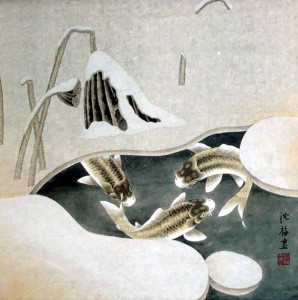
It happens every year, some of us like it, some of us don’t; but there is not stopping the on come of winter! For all of us ponders out there this means that we need to make some changes in how we are managing our ponds. During most of the year, pond keepers can all pretty much manage their ponds the same way. How we feed our fish, treat our plants, maintain our filters can all be approached with the same set of guidelines no matter the “zone” you are in. The winter months, however, will require pond keepers in the different zones to make changes; some subtle, some drastic.
So, how do you winterize your pond?
For pond keepers in the southern states Sandy Campbell from The Deep South Koi and Pond Society recommends feeding a wheat germ based (low temperature) food once or twice a week while temperatures are in the 45-50F range, then fasting fish stock for about 6 weeks during December/January. Around February the wheat germ based food should be provided again, and by March the fish should be feeding like crazy! Aquatic plants in the southern regions do not necessarily need to be cut back, sunk to the bottom or removed; and filter maintenance should be kept to it’s typical routine.
The winter months down south seem to not demand too much of the pond keeper as far as changing their routines, but this does not hold true for those pond keepers in the Pacific Northwest US. E Scott Hammond from Blue Creek Landscape (www.aquascapesbybluecreek.com) in Ellensburg, Washington can tell you a different story. Below freezing temperatures and 2 foot snowfalls are not uncommon in this part of the country. Scott recommends keeping the pond running, if possible, and let the pond oxygenate and de-gas on its own and enjoy the ice formations covering the running water on your pond. Trimming back taller plants, stop feeding fish at water temperatures below the mid 50’s, and adding a floating de-icer or small circulating (fountain type) pump also is good practice in these parts.
Yet fly just a few THOUSAND miles to the east and Sue DuBois from Chips Landscaping (www.chipslandscaping.net) in Greenfield Center, NY located in the Northeast US recommends netting over ponds in the 2nd/3rd week of September and switching over to cold water foods and bacteria treatments for the pond. By the 2nd week of October annual plants get removed and perennials get cut back and by early November the ponds get completely shut down; pumps out and de-icers in!
Here in the Mid-Atlantic region (www.loveyourpond.com) I start winterizing customer’s ponds in October and finish winterization services by early November. Our winterization service entails complete cleaning of the filter system coupled with a nice cold water bacteria treatment. Hardy plants get cut back and tropical plants get removed. Any equipment that cannot take winter conditions gets disconnected and stored at this time. Since September can be pretty hot in these parts the low temperature fish food doesn’t start until early October and feedings generally continue into mid-November until water temps stabilize in the lower 50F range, then the feedings stop until Spring. We cover our ponds with disposable leaf netting because around here the leaves come down heavy, but once the leaves are down the netting can come off. I too like having our ponds run all winter and favor using an aerator over the floating de-icer, but I install either one to keep an open area in the pond in the case of ice. Icing usually begins in late December, early January.
So what’s your winter routine? Winter is a great time of year to enjoy your pond from the indoors while sipping some coffee by your window view of your pond. Some amazing photos can be captured this time of year too. And don’t forget that your pond is a valuable water source for birds and small animals this time of year as water can become scarce in winter for the critters!

Leave a Reply